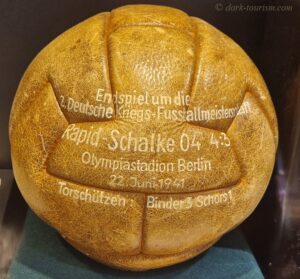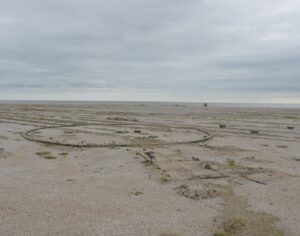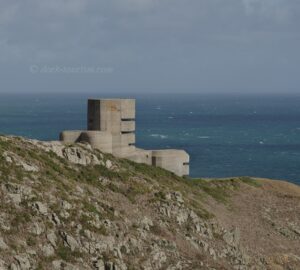On my recent trip to northern Germany, which was mainly for visiting friends and family, I nevertheless managed to slot in a visit (on the 1st of May – Labour Day!) to the vast memorial site at the former concentration camp of Neuengamme on the edge of Hamburg.
Far less well known than, say, Dachau or Buchenwald, Neuengamme was still one of the largest camps within the Third Reich, both by area size and by the number of inmates. About 100,000 inmates in total passed through the camp. And it was also one of the deadliest, with around 50% of those held and put to forced labour here not surviving.
I had been to Neuengamme twice before, first in the late 1990s before the current memorial commodification was in place and the site still felt rather forlorn and forgotten. Then I went again in 2008, after major changes had been implemented, with many of the remaining original structures made accessible and several topical exhibitions that go to great detail. In the entry for Neuengamme on my main website I called it “one of the richest documentation centres of its kind”. I still stand by that, though the exhibitions have aged a little by now.
In fact, on this recent revisit I found that not all that much has changed since 2008, so my website’s chapter will need only light editing and expansion. [UPDATE: this proved illusionary – in the end I almost completely rewrote the chapter from scratch to bring into line with the standards I have developed since this website’s early days in 2008.] But it will definitely be given a new photo gallery [UPATE: it has – and it’s also significantly more comprehensive than before]. As a precursor, I give you another topical photo essay here on the Blog, featuring 24 images that I took on my recent visit.
The first photo shows the administrative building in the background and the rectangular fields covered with broken stones inside little fences that symbolically mark the location of the original wooden barracks for the inmates, which have long since been dismantled:

Also no longer there are the electrified barbed-wire fences that surrounded the compounds for inmates. Instead, symbolic steel fence posts have been put up where the fences used to be:

In the main exhibition, there’s a large scale model of the camp as it would have looked in the later stages of its operation, and here you can see where the fences used to be as well:

On display in the main exhibition is also a salvaged single fence post, without the barbed wire but with the separators still there:

Also indoors in the exhibition are a couple of fragments of the former wooden barracks that somehow survived:
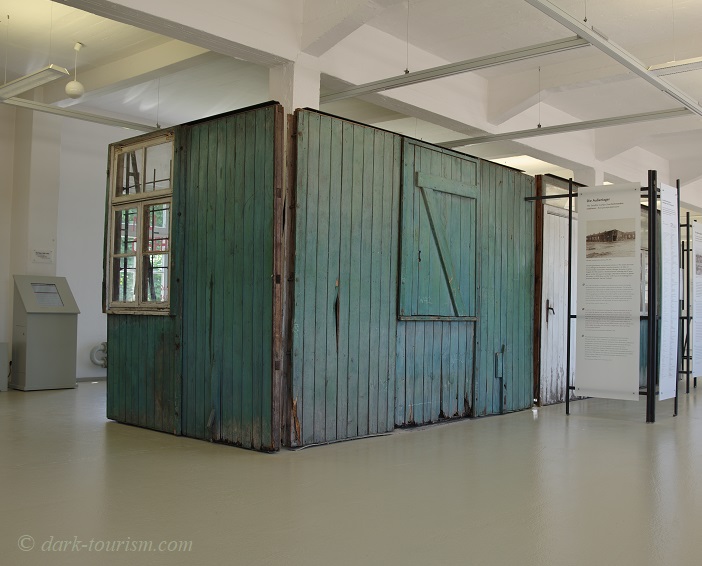
In addition there’s a model of such barracks plus additional ones without roofs or walls to reveal what the interior looked like, as in this photo, the latrines:
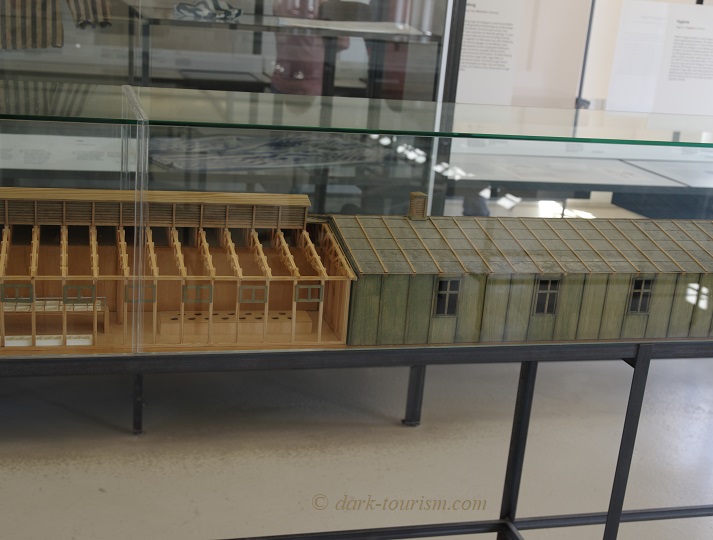
The exhibition is quite heavy on inmates’ personal stories, with whole folders about countless individuals, sometimes together with exhibits of personal belongings. Amongst the larger exhibits is this three-tier bunk bed for inmates:
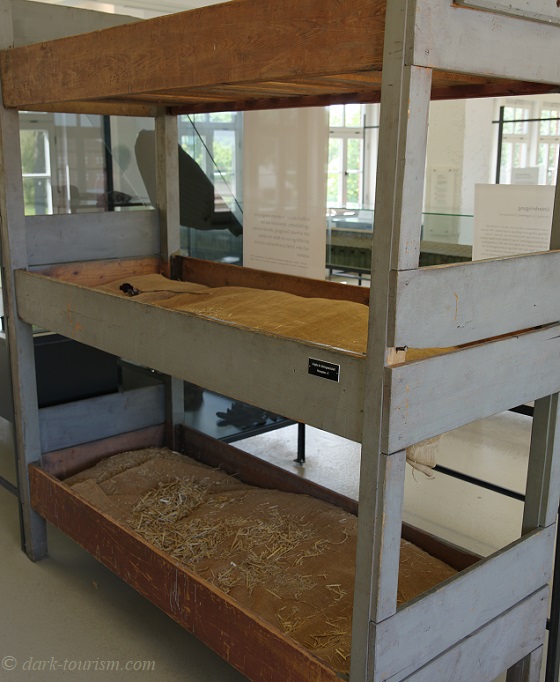
The usual striped concentration-camp-inmate clothes are also represented, of course, and in addition there’s one of the striped caps they had to wear on display:
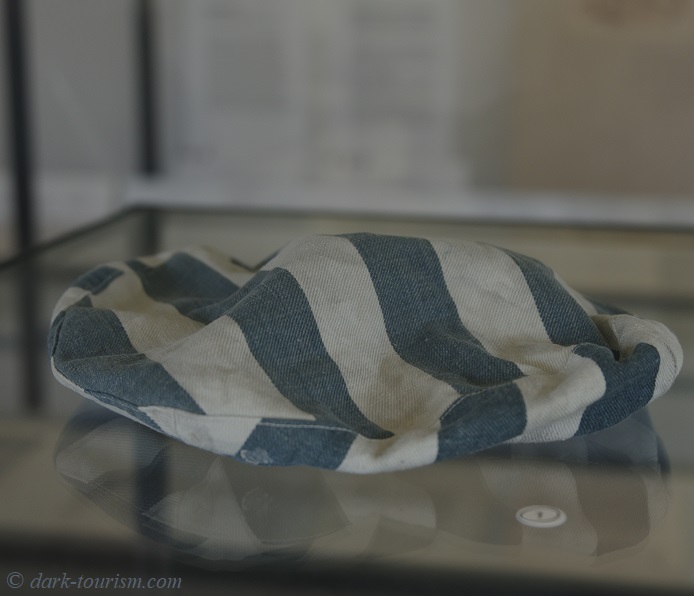
Another exhibit is this huge filing cabinet representing the bureaucratic efforts the Nazis went through in the running of their concentration camps:

One part of the exhibition is devoted to the tragic story of the ship Cap Arcona, which was used at the end of the war to transport “evacuated” camp inmates, but was mistaken for a troop transporter by the British RAF, who bombed the vessel just days before the end of WWII. Some 5000 people perished in the sinking, making this one of the deadliest disasters at sea ever. And the fact that the victims were mostly concentration camp evacuees, who were killed rather than liberated, makes this incident especially tragic. In the exhibition at Neuengamme, a Cap Arcona bell and several wreck pieces are now on display:
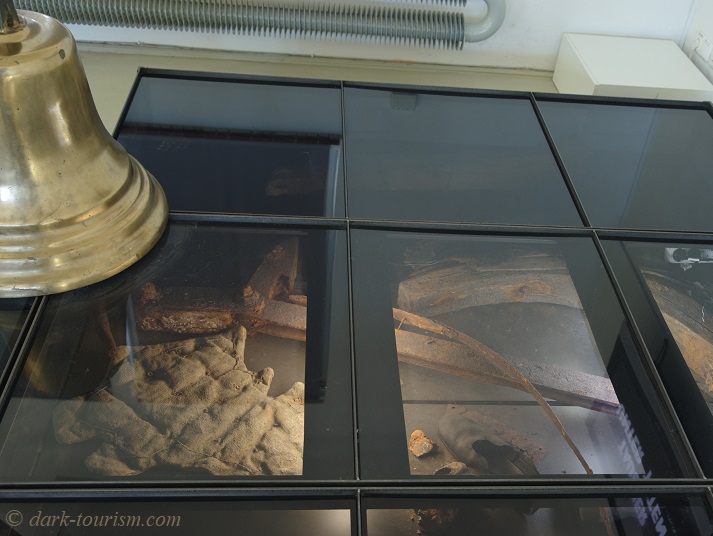
Back outside in the vast open area of the former camp stands a large open-air exhibit: a cattle-car-type railway carriage of the sort used in the deportation of victims and also for the transportation of inmates between camps:
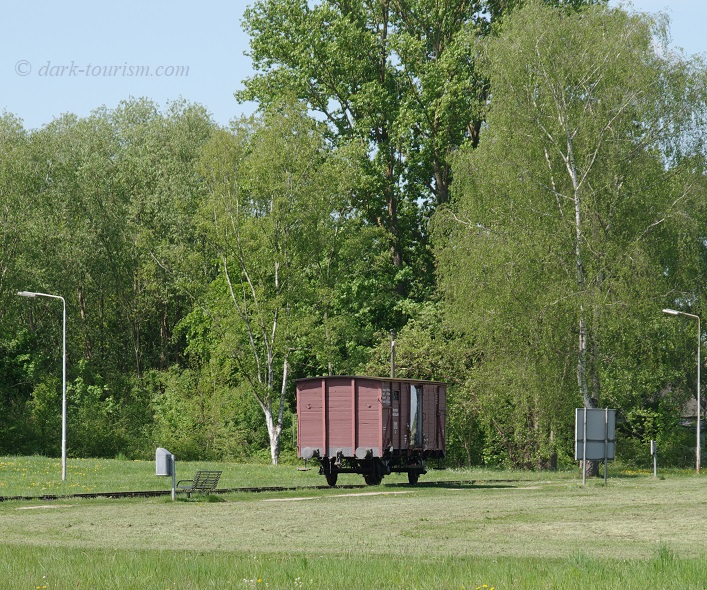
On the edge of the large field with the symbolic barracks-locator fields of stones is also a small patch with some original foundations. This is where the block of solitary confinement cells used to stand that was known informally by inmates as “the bunker”:
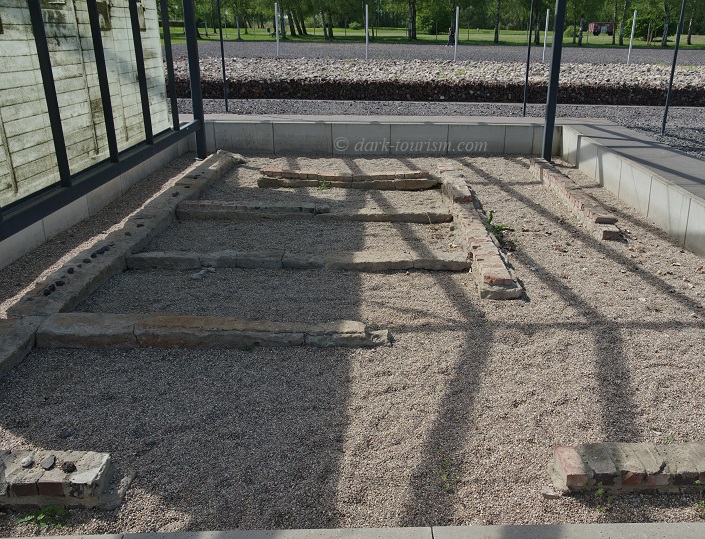
Neuengamme was primarily a place of forced labour – this consisted of different types of work, from hard manual labour, e.g. the digging of a canal, to more skilled work, e.g. in the specially erected branch of the Walther-Werke, famous for their small arms, parts of which were produced in this rather well-preserved ensemble of single-storey brick buildings:
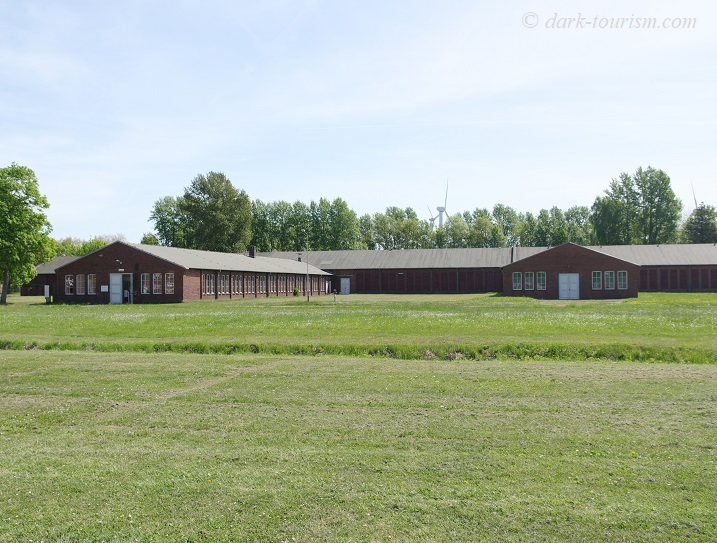
Inside one of the wings of this compound is a separate exhibition specifically about forced labour at Neuengamme. Another block provides space for temporary exhibitions, but at the time of my visit this part was locked, so it was presumably not in use then.
Another permanent exhibition can be found in what used to be the SS garages:
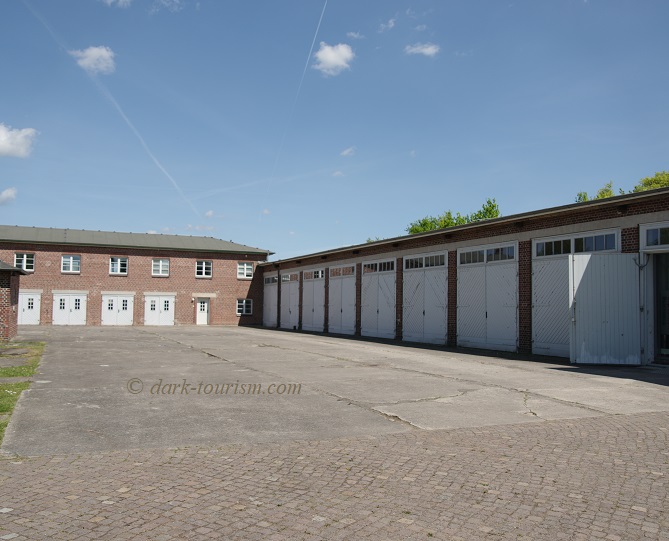
The exhibition inside focuses mainly on the perpetrators, and again there are numerous individual personal stories to explore here, presented on text panels as well as in folders with copious additional material. These make for some disturbing reading … Artefacts on display in this part are thin on the ground, but include some items of furniture taken from the commandant’s house:

The actual commandant’s villa still stands to the east of the SS garages, but its interior is not accessible to the public – although its gate invites creative photography:
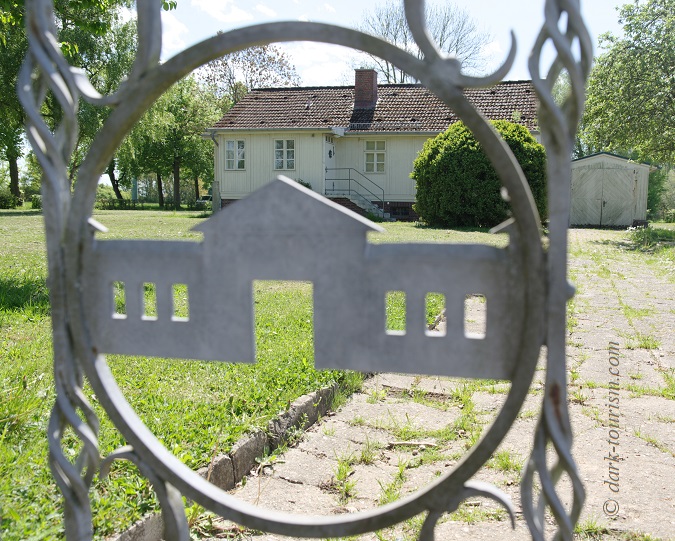
A particularly controversial aspect of Neuengamme’s post-war history is the fact that a prison was constructed right in the middle of the former concentration camp’s grounds! In fact it was more than one prison. As early as the late 1940s there was a prison for men, later a new complex was constructed and opened in 1970: a special prison for juvenile delinquents. All this against the protests of former camp inmates. From the 1980s, local organizations joined the protests and pressure to end the inappropriate coexistence of a concentration-camp-memorial and working prisons gained momentum. After years of campaigning it was finally decided to move the prisoners and demolish the modern prison buildings, as part of a complete overhaul and expansion of the site as a memorial. Only one small section of the juvenile-delinquents prison wall with one watchtower on top was preserved in 2007 to document this unsavoury part of the camp’s post-war history. The contrast to the original camp’s structures remains palpable:
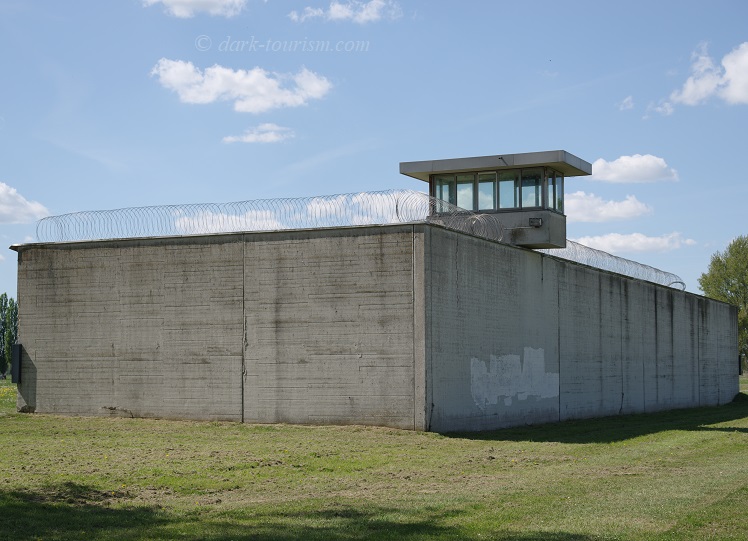
The largest original part of the former camp is the so-called “Klinkerwerk”, a brickworks plant. This was one of the main “industries” here, in which camp inmates had to do forced labour, producing bricks for the planned large-scale redesign of Hamburg in the Nazi style (similar to the plans for a new “Germania” in Berlin). This is the front of the middle one of the three wings of the brickworks, with a ramp for a narrow-gauge railway line:

You can climb to the top of the ramp to get a bird’s eye view of the surroundings. When I was there it was the day before the 80th anniversary of the camp’s liberation by British troops on 2 May 1945 – and preparations were under way for a major ceremony marking that date:

Of the three big wings of the “Klinkerwerk” only the eastern-most one is open to the public. The vast cavernous interior with light filtering through little windows in the roof making patterns on the stone floor is perhaps the visually most impressive sight of all at Neuengamme (same image as the featured one at the top of this post):
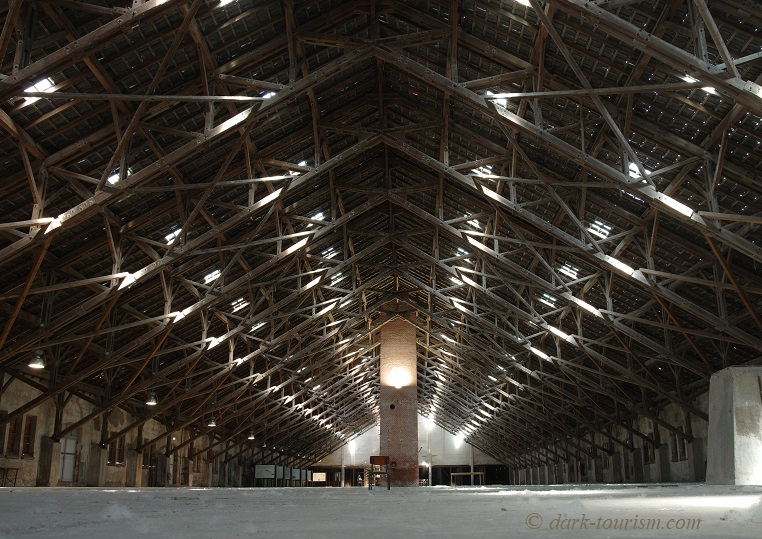
At the rear of this huge hall is another small exhibition, this time about the brickworks and its history. Beyond are the remnants of the big brick-drying ovens:
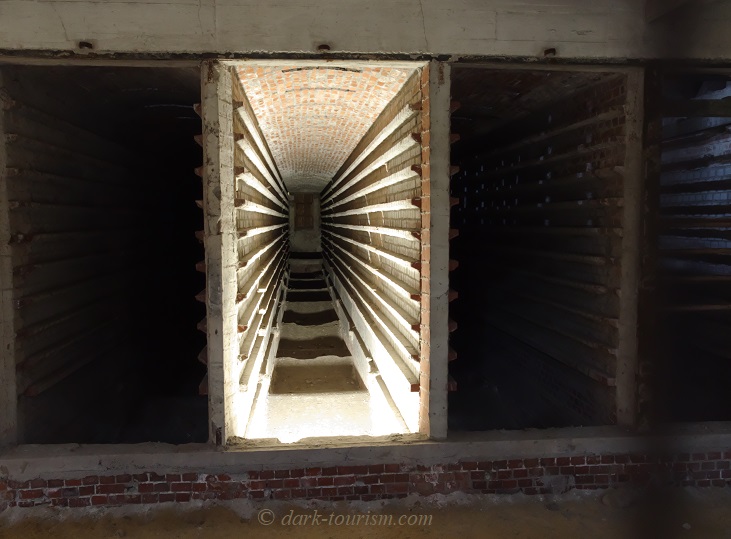
What was once the only commemoration site at Neuengamme now leads a bit of a wallflower existence. I mean the “Mahnmal” (memorial) part at the northern end of the area, dominated by a tall column erected in 1965 (to replace a smaller initial monument from 1953) and with several horizontal memorial plaques for different nationalities and groups of victims. Here’s a photo of that part:

Added to this in 1981 was a “documentation house”, which after the creation of the more elaborate exhibitions in the original camp buildings in the 2000s was turned into a simple memorial hall, with the inner walls clad with lists of names of victims. This is what it looks like from the outside:
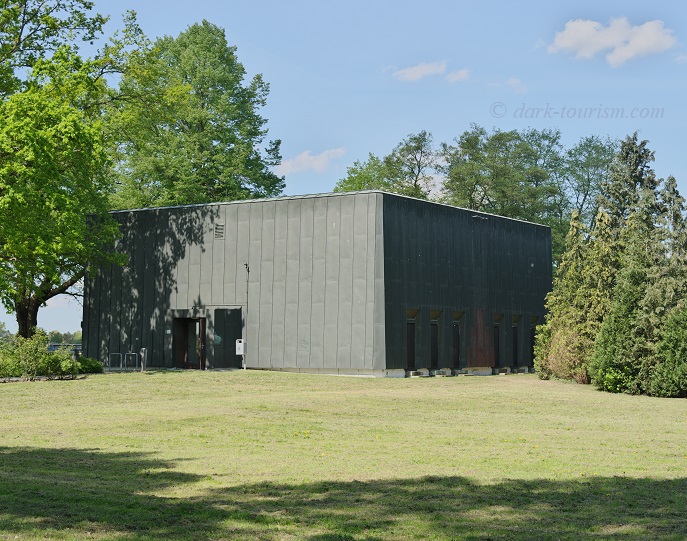
Finally here’s the sculpture at the foot of the tall column, whose name is given either as “The Fallen” or “Le Deporté”:

But so much for now and Neuengamme. I’ll update the chapter on my main website in due course too – so do check back there later.

